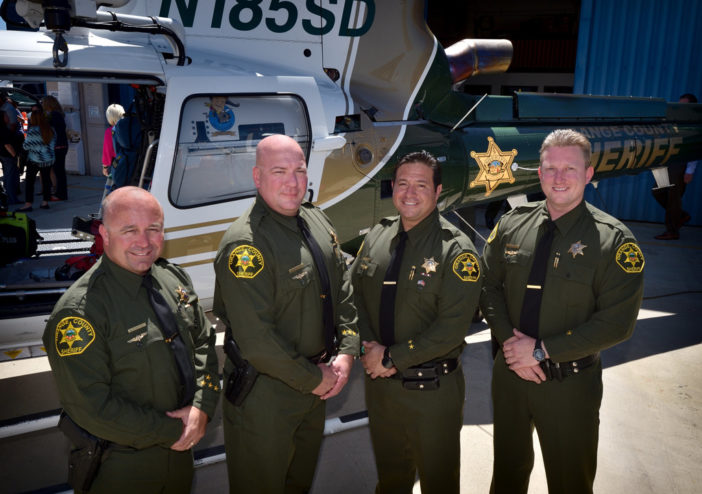The perp had no clue.
After he broke into a pharmacy in La Habra in the predawn hours one morning last year, he bolted on foot to evade patrol officers.
At one point, the bad guy hopped into a swimming pool to hide.
Then he hid in a Dumpster.
The burglar and dope fiend never realized that 800 feet above him, members of the Orange County Sheriff’s Department’s Air Support Unit had watched his every move.
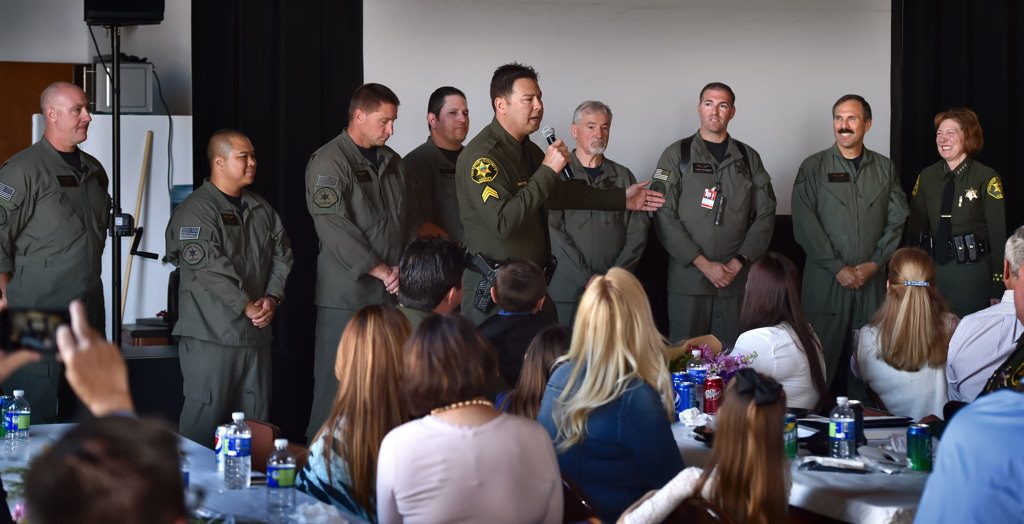
Members of the OCSD Aviation Support Unit are recognized during the OCSD 2017 Wings Ceremony at John Wayne Airport.
Photo by Steven Georges/Behind the Badge OC
And they directed officers on the ground where to go to take the miscreant into custody.
Deputy Joe Kantar, who formally received his pilot wings at a ceremony last week at the Air Support Unit’s hangar at John Wayne Airport, was piloting the helicopter, part of the OCSD’s Duke Air Support Unit, on that call.
Kantar has a message for law-breakers on the ground:
“I’m going to find you,” Kantar said. “And you’re going to jail.”
Kantar and other members of the Air Support Team have earned their swagger.
Becoming a pilot or a tactical officer — the non-pilot half of the crew who is the primary decision-maker and the voice, eyes and ears of the aircraft — is one of the biggest achievements for an OCSD deputy, requiring arduous and extensive training and a thirst for thriving in a chaotic, high-pressure environment.
Sheriff Sandra Hutchens and several law enforcement and civic leaders were on hand March 29 for the OCSD’s annual wings-pinning ceremony.
At this year’s event, with relatives and friends and colleagues watching, Kantar and Deputy Brian Fischer received their pilot wings, while two other deputies — Carlo DiGanci and Brian Stockbridge — received their tactical flight officer wings.

Deputy Carlo DiGanci stands with his family as he receives his OCSD Tactical Flight Officer plaque from OC Sheriff Sandra Hutchens during the OCSD 2017 Wings Ceremony.
Photo by Steven Georges/Behind the Badge OC
To become a pilot, one first must excel as a tactical flight officer (TFO).
“You’re moving at 90 knots while monitoring a half dozen radio channels, controlling a camera and other equipment, and you’ve got to be OK with that environment,” Stockbridge said of the job of TFO.
Sgt. Bill Fitzgerald, also a pilot, called earning one’s wings “a very big accomplishment.”
Fitzgerald said he believes TFO is one of the most difficult jobs there is within the OCSD — even more difficult than pilot.
Three of the last six TFO applicants failed training, Fitzgerald noted. TFO applicants must complete seven months of intensive training to earn his or her wings. The success rate for completing training is about 50 percent.

Deputy Brian Stockbridge receives his OCSD Tactical Flight Officer plaque from OC Sheriff Sandra Hutchens during the OCSD 2017 Wings Ceremony.
Photo by Steven Georges/Behind the Badge OC
Inside the helicopter, TFOs must be able to successfully deploy the FLIR Star Safire 380HDc Camera, Trakkabeam Searchlight, PowerSonix Public Address System and the Aerocomputers Moving Map System.
To become a pilot, a deputy must complete about one year of flight training and must complete the requirements for the Federal Aviation Administration Private Pilot Helicopter License and the FAA requirements for the Commercial Helicopter License.
The deputy then must complete in-house pilot training focusing on the specific tasks needed to be successful as a law enforcement pilot. After obtaining a minimum of 500 helicopter flight hours, he or she will be awarded his or her wings.
After guests dined on a catered lunch of tri tip, ribs and chicken to the sound of planes landing and taking off on the nearby JWA runways, Fitzgerald played a video of highlights of pursuits, arrests and rescues in 2016.
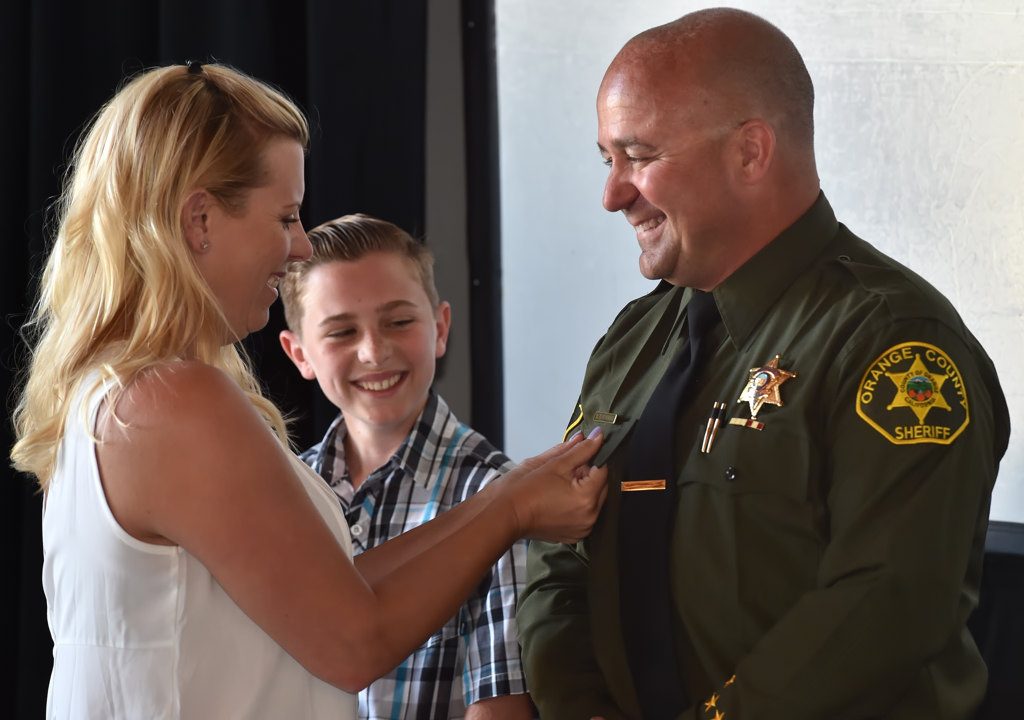
Deputy Brian Stockbridge has his OCSD Tactical Flight Officer Wings pinned to him by his wife during the OCSD 2017 Wings Ceremony.
Photo by Steven Georges/Behind the Badge OC
One clip showed the aforementioned pool-dipper getting busted, while other scenes included suspects being dragged around by OCSD K9s and dramatic rescues in O.C.’s rugged coastal and backcountry terrain.
Last year was a milestone year for the Air Support Unit, Fitzgerald said. The unit acquired two helicopters, expanded the scope of its search-and-rescue mission, and reconstructed a maintenance contract that saved the OCSD $176,000, Fitzgerald said.
Fitzgerald also highlighted the expertise of several unpaid reserve deputies who assist the full-time members of the Air Support Unit (click here to read about one of them, Public Service Responder Deputy Jim Slikker).
Fitzgerald also mentioned a Nov. 18, 2016 rescue in very challenging terrain along the Main Divide. A man riding a motorcycle crashed and broke his hip. But because of the quick response of the Air Support Unit, the man now is walking around and nearly back to 100 percent. Doctors credited the rapid rescue for his strong recovery.

Deputy Joseph Kantar stands with his family as he receives his OCSD Pilot plaque from OC Sheriff Sandra Hutchens during the OCSD 2017 Wings Ceremony.
Photo by Steven Georges/Behind the Badge OC
After the ceremony, guests were invited onto Duke 1 and Duke 2 for “mission equipment orientation flight” that allowed them to get an understanding of the equipment utilized by the pilot and TFO.
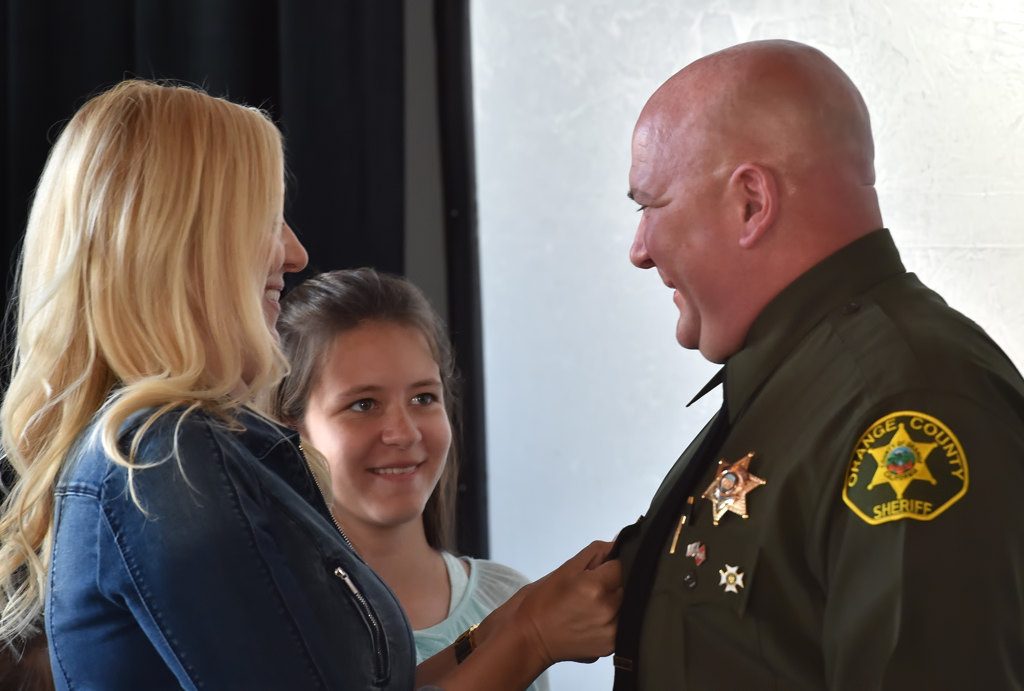
Deputy Joseph Kantar has his OCSD Pilot Wings pinned to him by his wife during the OCSD 2017 Wings Ceremony.
Photo by Steven Georges/Behind the Badge OC

Deputy Brian Fischer stands with his family as he receives his OCSD Pilot plaque from OC Sheriff Sandra Hutchens during the OCSD 2017 Wings Ceremony. Photo by Steven Georges/Behind the Badge OC
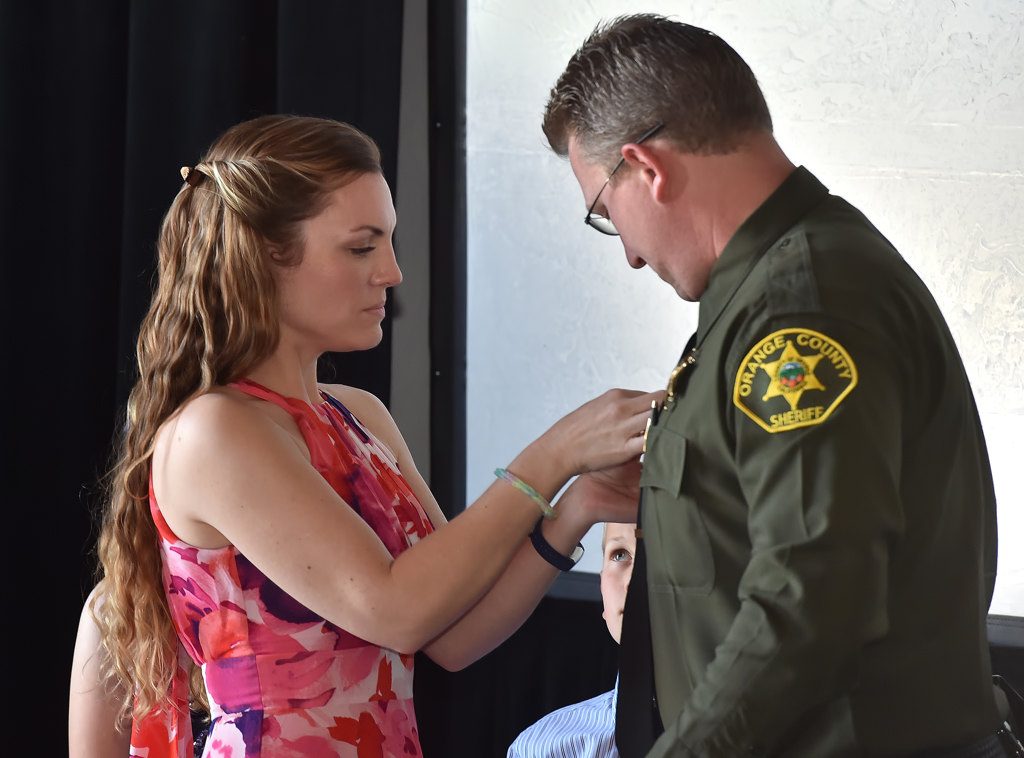
Deputy Brian Fischer has his OCSD Pilot Wings pinned to him by his wife during the OCSD 2017 Wings Ceremony.
Photo by Steven Georges/Behind the Badge OC
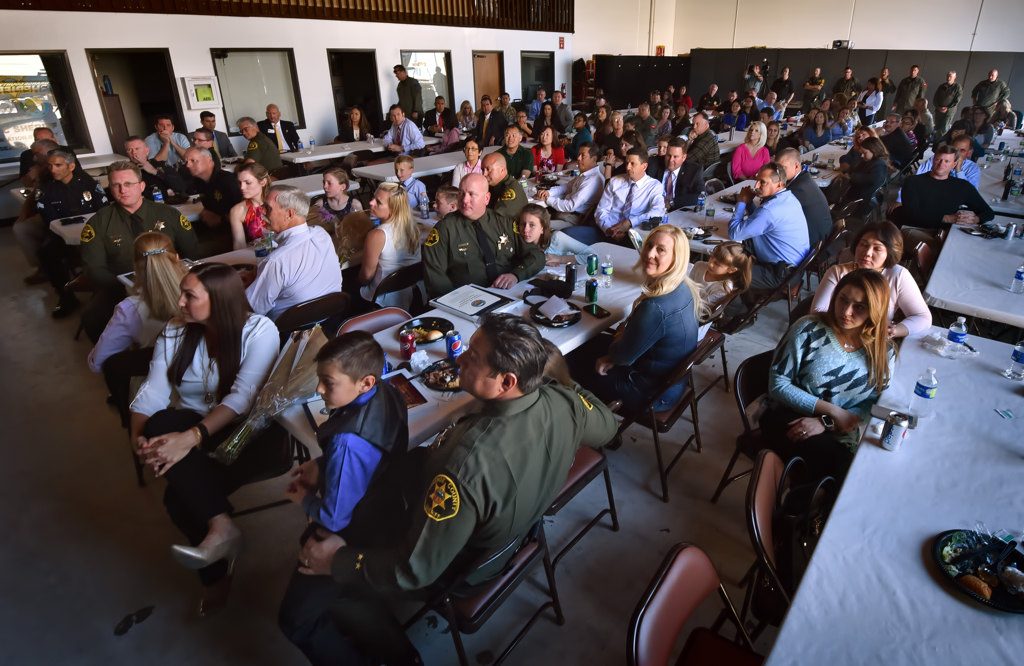
Family, friends and coworkers attend the OCSD 2017 Wings Ceremony at John Wayne Airport.
Photo by Steven Georges/Behind the Badge OC
 Behind the Badge
Behind the Badge
